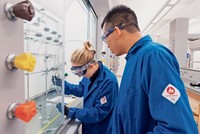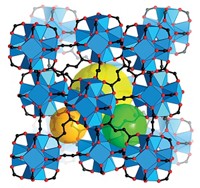Advertisement
Grab your lab coat. Let's get started
Welcome!
Welcome!
Create an account below to get 6 C&EN articles per month, receive newsletters and more - all free.
It seems this is your first time logging in online. Please enter the following information to continue.
As an ACS member you automatically get access to this site. All we need is few more details to create your reading experience.
Not you? Sign in with a different account.
Not you? Sign in with a different account.
ERROR 1
ERROR 1
ERROR 2
ERROR 2
ERROR 2
ERROR 2
ERROR 2
Password and Confirm password must match.
If you have an ACS member number, please enter it here so we can link this account to your membership. (optional)
ERROR 2
ACS values your privacy. By submitting your information, you are gaining access to C&EN and subscribing to our weekly newsletter. We use the information you provide to make your reading experience better, and we will never sell your data to third party members.
Business
How One Entrepreneur Is Making Rotary Evaporators Cool Again
Start-up firm Ecodyst is debuting a condenser that it promises will save money, water, and the cost of dry ice
by Marc S. Reisch
February 1, 2016
| A version of this story appeared in
Volume 94, Issue 5

Rotary evaporators, which chemists fondly refer to as rotovaps, are used to swirl a sample in a round-bottom flask like a wine connoisseur swirls an expensive glass of Bordeaux. But instead of trying to draw out the bouquet and taste as a connoisseur would for wine, chemists use rotovaps to remove solvents from a completed organic reaction, leaving the desired product behind.

Commercialized in 1957 by the Swiss company Büchi, the vacuum-assisted devices turn sample flasks in heated baths to draw out solvent vapors through a series of tubes. The condensed solvents can be disposed of or reused, and the samples left behind go on for further analysis.
Rotovaps populate the benches in academic, life sciences, forensic, and materials research labs. Dependable workhorses of organic chemistry, they haven’t changed much in the past half-century. But now George Adjabeng, a medicinal chemist from Ghana with an entrepreneurial flair, has developed a rotovap accessory called the EcoChyll that he says will make rotovaps more efficient and ultimately less costly to operate.
The EcoChyll is a refrigerated cooling device that attaches to a rotovap and is meant to condense solvent vapors removed from a sample. Plug in the unit and set it up in place of a traditional water-cooled or dry-ice condenser, and the unit can cool down to –20 °C in less than one minute. It also doesn’t need constant monitoring, Adjabeng says.
“It’s always available and ready to go,” says Adjabeng, who recently got a degree from the Kenan-Flagler Business School at the University of North Carolina, Chapel Hill. He started his firm, called Ecodyst, two years ago with his friend Kwabena Williams, a manufacturing executive.
Many labs depend on glass condensers filled with dry ice to liquefy solvent vapors. In other cases, labs use a spiral-wound glass tube filled with water drawn from the tap to cool down the condenser. Once used, the water goes down the drain.
Current refrigeration-based systems cool down a mixture of antifreeze and water externally and circulate it through a spiral glass tube chiller. They go only as low as –10 °C, Adjabeng says, and take as much as a half-hour to cool.
What’s different about the EcoChyll is that the unit’s condenser contains a refrigerant-filled copper coil surrounded by a proprietary metallic alloy to prevent solvent attack. By putting refrigerant-filled coils inside, the EcoChyll condenser cools more efficiently and rapidly than does a water-based system, according to Ecodyst, and can go as low as –40 °C.
“No one thought of doing that before,” Adjabeng says. Ecodyst now has one patent issued on its approach and three more pending, he says.
Adjabeng points to additional advantages of the condenser he has developed. Condensers that cool with a continuous flow of tap water are wasteful. Labs dependent on dry-ice-cooled condensers require a dependable source of dry ice and constant monitoring. “Dry ice evaporates very quickly,” he says. And because glass is a poor conductor of heat, “you don’t get the full benefit of the dry ice,” he adds.
Adjabeng’s experience with rotovaps started at Ghana’s University of Cape Coast. After graduating in 2001, he received an M.S. degree in organic chemistry from Ontario’s Brock University and went to work for Roche in California. From 2004 to 2011, he worked for GlaxoSmithKline in North Carolina where he was a discoverer of Tafinlar, a drug that treats advanced melanoma.
“I used rotovaps while I was in school and at work,” Adjabeng says. At times, he says, “I’d spend all day going back and forth getting dry ice to recharge the rotovap condenser.”
He left GSK to get a business degree because, he says, “I didn’t want to be in the lab for the rest of my career.” During his studies, he was bitten by the entrepreneurial bug. “I met people who had started up university-research-based spin-outs,” he says.
Seeking a technology of his own, Adjabeng recalled his experience in the lab and conceived of the EcoChyll. He also sought out people familiar with refrigeration technology and worked with the department of mechanical and aerospace engineering at North Carolina State University to develop the prototype he is now testing with potential users.
Adjabeng and his friend initially funded development of the EcoChyll out of their own pockets. More recently, an angel investor kicked in $100,000.
Planning to test the EcoChyll in his lab is University of California, Berkeley, chemistry professor Richmond Sarpong. Given California’s water shortage, Sarpong notes, tap water cooling is rarely used. “But we use a lot of dry ice. It’s expensive and not the most sustainable thing,” he says.
Bruce Pitner, chief scientific officer at Nirvana Sciences, a near-infrared diagnostic dye start-up in Research Triangle Park, N.C., has already tried the EcoChyll. The unit is more efficient than refrigerated recirculating water-antifreeze chillers and takes up less space, he says.
Depending on the price, Pitner, who spends more than $50 per week to pick up dry ice from a local supplier, says he’d be interested in buying the unit. “At a small firm, efficiency counts, and every dollar is important,” he says.
At large academic labs where dry ice is readily available, not everyone resents the fetching chores. Kevin A. Robb, who is working on a Ph.D. in organic chemistry at the University of Illinois, Urbana-Champaign, says, “Dry ice is incredibly easy to use.” As he sees it, “unless the university realizes cost savings, I don’t think refrigerated condensers would make all that much difference.”
Adjabeng says he hasn’t settled on a price for the EcoChyll unit yet. But given that traditional rotovaps consume $3,000 or more of dry ice per year, he figures he could charge three to four times that amount for the EcoChyll. With the 10-year life expectancy he predicts for the tool, Adjabeng suggests labs will get a bargain.
For rotovap users, he says, buying an EcoChyll will be like going from a flip phone to a smartphone. “I figure it’s worth a premium,” he says.





Join the conversation
Contact the reporter
Submit a Letter to the Editor for publication
Engage with us on Twitter